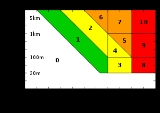
Gravitational keyhole
Encyclopedia
A gravitational keyhole, or resonance keyhole, is a small region of space that could alter the course of a passing asteroid
due to a planet's gravity in a way that could cause such an asteroid to collide with that planet on its next orbital pass. The word "keyhole" contrasts the vastness of space with the relatively tiny region through which a body might pass, and is not a reference to its shape.
If an asteroid were to pass a planet at a distance that changed its orbit just the right amount, the asteroid would collide with the planet on its next fly-by. The distance which causes this to happen is the location of the keyhole.
was once estimated to have a 2.7% (1 in 37) chance of striking the earth in 2029. Further observations and revisions of the estimated path of the asteroid have ruled out impact in 2029, but identified a 2000 feet (609.6 m) wide keyhole that the asteroid may pass through on its approach in 2029, thereby causing a deflection that may result in impact in 2036; currently, the estimated probability of impact in 2036 is 1 in 250,000 (0.0004%). Apophis is estimated to be as large as 1300 feet (396.2 m) across, and could cause millions of casualties if it were to hit Earth.
Scientists from the B612 Foundation
, a private foundation dedicated to protecting the Earth from asteroid strikes, have proposed that Apophis be nudged out of its present orbit into an orbit that takes it further from the keyhole. NASA scientist David Morrison says, "After 2029, the deflection would have to be vigorous enough to miss not just a tiny keyhole but the much larger target of the Earth itself. And such a deflection is far beyond present technology for an asteroid this large."
Additional observations of the trajectory of Apophis revealed the keyhole would probably be missed. As of October 19, 2006, the impact probability for April 13, 2036, was calculated as 1 in 45,000. An additional impact date in 2037 was also identified; the impact probability for that encounter was calculated as 1 in 12.3 million.
Asteroid
Asteroids are a class of small Solar System bodies in orbit around the Sun. They have also been called planetoids, especially the larger ones...
due to a planet's gravity in a way that could cause such an asteroid to collide with that planet on its next orbital pass. The word "keyhole" contrasts the vastness of space with the relatively tiny region through which a body might pass, and is not a reference to its shape.
Explanation
When an asteroid passes by a planet, the gravitational attraction of the planet pulls on the asteroid and deflects it from its original trajectory, thus changing its orbit. The amount of change depends on the distance of closest approach of the asteroid to the planet: the closer the asteroid comes to the planet, the larger the deflection will be.If an asteroid were to pass a planet at a distance that changed its orbit just the right amount, the asteroid would collide with the planet on its next fly-by. The distance which causes this to happen is the location of the keyhole.
The Apophis deflection
The asteroid named Apophis99942 Apophis
99942 Apophis is a near-Earth asteroid that caused a brief period of concern in December 2004 because initial observations indicated a small probability that it would strike the Earth in 2029. Additional observations provided improved predictions that eliminated the possibility of an impact on...
was once estimated to have a 2.7% (1 in 37) chance of striking the earth in 2029. Further observations and revisions of the estimated path of the asteroid have ruled out impact in 2029, but identified a 2000 feet (609.6 m) wide keyhole that the asteroid may pass through on its approach in 2029, thereby causing a deflection that may result in impact in 2036; currently, the estimated probability of impact in 2036 is 1 in 250,000 (0.0004%). Apophis is estimated to be as large as 1300 feet (396.2 m) across, and could cause millions of casualties if it were to hit Earth.
Scientists from the B612 Foundation
B612 Foundation
The B612 Foundation is a private foundation dedicated to protecting the Earth from asteroid strikes. Their immediate goal is to "significantly alter the orbit of an asteroid in a controlled manner by 2015"....
, a private foundation dedicated to protecting the Earth from asteroid strikes, have proposed that Apophis be nudged out of its present orbit into an orbit that takes it further from the keyhole. NASA scientist David Morrison says, "After 2029, the deflection would have to be vigorous enough to miss not just a tiny keyhole but the much larger target of the Earth itself. And such a deflection is far beyond present technology for an asteroid this large."
Additional observations of the trajectory of Apophis revealed the keyhole would probably be missed. As of October 19, 2006, the impact probability for April 13, 2036, was calculated as 1 in 45,000. An additional impact date in 2037 was also identified; the impact probability for that encounter was calculated as 1 in 12.3 million.

